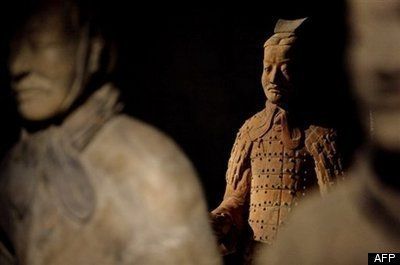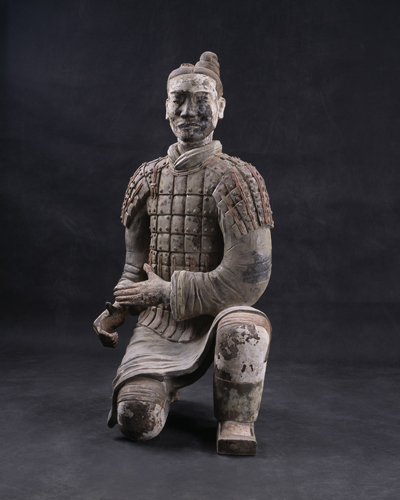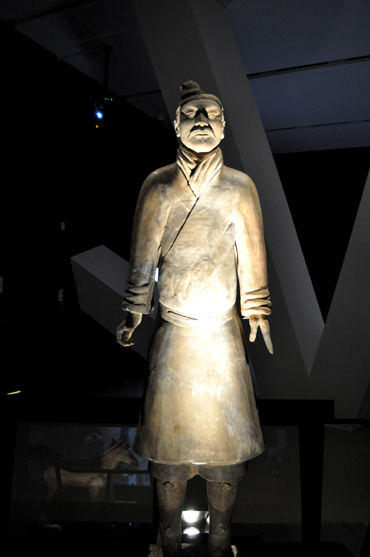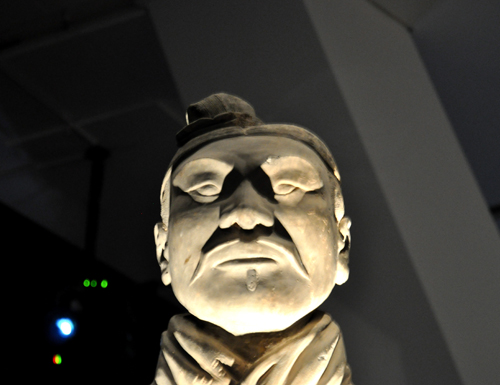
Less than 40 years ago in the Shaanxi province of north-central China, farmers accidentally unearthed fragments of what would become one of the world's greatest archaeological finds: the Terracotta Army of Warrior Emperor Ying Zheng.

Terracotta Army Pit No.1, Emperor Qin Shihuang's Terracotta Army Museum. Photo courtesy of the Royal Ontario Museum.
Since that first incredible discovery in 1974, archaeologists have unearthed approximately 2,000 full-sized terracotta warriors and horses from three ancient pits, yet the terracotta site is in fact only a minor component of a much grander tomb construction under which lie thousands of treasures waiting to be excavated. Considered by some to be the 8th wonder of the world, this extraordinary site became a UNESCO World Heritage Site in 1987 and continues to be a shining symbol of China's rich cultural history.

Warrior and horse. The Warrior Emperor and China's Terracotta Army Exhibit at the ROM. Photo courtesy of Mallorie Bronfman-Thomas.
The Royal Ontario Museum in Toronto, Canada has done an incredible job of creating an exhibit rich in scope and contextualization, making it "the most significant display of the First Emperor's Terracotta Army ever showcased in North America", says Dr. Chen Shen, Senior Curator and Bishop White Chair of East Asian Art & Archaeology at the ROM. By exploring the terracotta figures in a broad historical and social context, this exhibition highlights the life, times and afterlife of the First Emperor of the Qin Dynasty, therein illuminating a historical period rife with political and social transitions, not least of which was the monumental move from war to peace.

Kneeling Archer.Emperor Qin Shihuang's Terracotta Army Museum. Photo courtesy of the Royal Ontario Museum.
Fittingly presented underground in the ROM's cavernous basement, the exhibit leads visitors through three distinct sections: The Rise of Qin, The Terracotta Army and The Harmonious Han. Ensconced in a dramatic play of light and shadow The Terracotta Army is unarguably the most visually powerful part of the exhibit, however all sections are impressive and enlightening in their own ways, and without a doubt worth seeing.

Terracotta Warrior. The Warrior Emperor and China's Terracotta Army Exhibit at the ROM. Photo courtesy of Mallorie Bronfman-Thomas.
Ying Zheng's autocratic rule lasted 37 years and saw incredible tyranny alongside incredible development, yet despite his controversial role in history, the Terracotta Warriors represent the greatest evidence of his legacy. The construction of the mausoleum started when he was just 13 years old and required more than 700,000 workers to complete the various warriors and sculptures, who Zheng thought would protect him in the afterlife. Recent archaeological findings suggest that the underground tomb complex may actually resemble a grand underground palace complete with royal gardens.
You can't stroll through Ying Zheng's underground palace in China but you can feast your eyes on a mesmerizing array of ancient artifacts deemed powerful enough to protect an Emperor in his afterlife. Don't miss this once-in-a-lifetime exhibit on now through to December at the Royal Ontario Museum.

Up-close warrior shot. The Warrior Emperor and China's Terracotta Army Exhibit at the ROM. Photo courtesy of Mallorie Bronfman-Thomas.
For more articles and blogs visit www.marissabronfman.com
